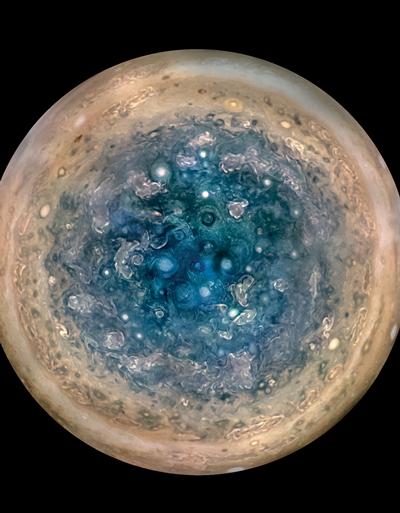The independent pulse of Jupiter’s X-ray auroras

Jupiter’s intense northern and southern lights pulse independently of each other according to new research using the European Space Agency’s XMM-Newton and NASA’s Chandra X-ray observatories.
Dr Caitriona Jackman, Associate Professor of Space Physics at the University of Southampton, contributed to the study, published in Nature Astronomy. The study, led by William Dunn from University College London (UCL) used data from a Chandra Space Telescope campaign proposed by Dr Jackman. The study found that very high-energy X-ray emissions at Jupiter’s south pole consistently pulse every 11 minutes. Meanwhile those at the north pole are erratic: increasing and decreasing in brightness, independent of the south pole.
This behaviour is distinct from Earth’s north and south auroras which broadly mirror each other in activity. Other similarly large planets, such as Saturn, do not produce any detectable X-ray aurora, which makes the findings at Jupiter particularly puzzling.
“Jupiter’s auroral X-ray emissions are the most powerful in our solar system, and their study provides unique insight into the origin, dynamics and acceleration of charged particles in the Jovian magnetosphere,” said Dr Jackman. “Now is a fantastic time to study Jupiter, as the Juno spacecraft is taking high resolution in situ measurements of the magnetic field and particles which can help to constrain our theories of what causes the powerful X-rays.
“Jupiter is a fascinating environment for astronomers and planetary scientists to study,” Dr Jackman continued. “It is easy to spot in the night sky with the naked eye, but powerful telescopes (including those such as Chandra and XMM which work in X-ray wavelengths) can unveil ever more detail, including these dynamic auroral X-ray hot spots.
Lead author William Dunn from the University College London Mullard Space Laboratory, said the research team didn’t expect to see Jupiter’s X-ray hot spots pulsing independently. It was thought their activity would be coordinated through the planet’s magnetic field.
“We need to study this further to develop ideas for how Jupiter produces its X-ray aurora and NASA’s Juno mission is really important for this,” explained Dr Dunn who is also associated with the Harvard-Smithsonian Center for Astrophysics in the USA.
Since arriving at Jupiter in 2016, the Juno mission has been re-writing much of what is known about the giant planet, but the spacecraft does not have an X-ray instrument on board. To understand how the X-ray aurora are produced, the team hope to combine the X-ray aurora information gathered using XMM-Newton and Chandra with data collected by Juno as it explores the regions producing Jupiter’s aurora.
“If we can start to connect the X-ray signatures with the physical processes that produce them, then we can use those signatures to understand other bodies across the Universe such as brown dwarfs, exoplanets or maybe even neutron stars. It is a very powerful and important step towards understanding X-rays throughout the Universe and one that we only have while Juno is conducting measurements simultaneously with Chandra and XMM-Newton,” said Dr Dunn.
One of the theories that Juno may help to prove or disprove is that Jupiter’s auroras form separately when the planet’s magnetic field interacts with the solar wind. The team suspect that the magnetic field lines vibrate, producing waves that carry charged particles towards the poles and these change in speed and direction of travel until they collide with Jupiter’s atmosphere, generating X-ray pulses.
Using the XMM-Newton and Chandra X-ray observatories in May to June 2016 and March 2007, the authors produced maps of Jupiter’s X-ray emissions and identified an X-ray hot spot at each pole. Each hot spot covers an area much bigger than the surface of the earth. Studying each to identify patterns of behaviour, they found that the hot spots have very different characteristics.
The team hopes to keep tracking the activity of Jupiter’s poles over the next two years using X-ray observing campaigns in conjunction with Juno to see if this previously unreported behaviour is commonplace.
The UCL and Harvard-Smithsonian-led study also involved researchers from Lancaster University, University of Southampton, NASA Marshall Space Flight Center, Universite de Liege, Boston University, Southwest Research Institute (SwRI), Jet Propulsion Laboratory, Caltech, MIT and Universidad Pontificia Comillas. It was kindly funded by the Science and Technology Facilities Council (STFC), ESA, the Natural and Environmental Research Council (NERC) and UCL.
Click here to download the paper ‘The independent pulsations of Jupiter’s northern and southern X-ray auroras’ (DOI10.1038/s41550-017-0262-6, Nature Astronomy).